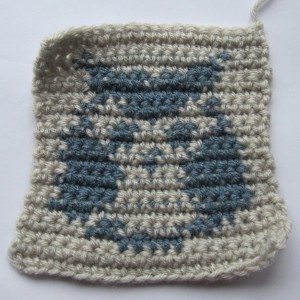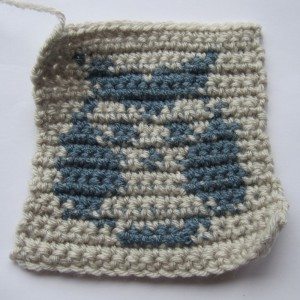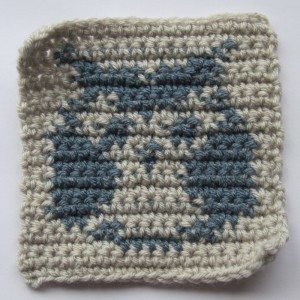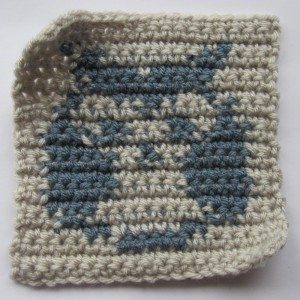In part 2 of beginning crochet, I teach basic color work. I don’t do a lot of color work, and when I do it’s typically in a case where the unused color can hang out loose behind the work, so it’s based on less experience than pretty much the entire remainder of the course. I was practicing before the most recent iteration, and made the following from a cross-stitch pattern:


Holy tension problems, Batman! As a note, this was made with worsted-weight yarn and an H hook (5mm). I tried again, resisting with all my might the urge to tug the yarn down when I switched colors:


Immediately after I finished the piece some of the carried yarn was peeking out between the strands of the yarn in use, but I stretched the finished piece vertically and then horizontally and they all disappeared. Apparently for me the key is to hang loose.
So, then, that’s all about practice, but what can be done about the exploded mess that is the back side of the stitch? It seemed perhaps I’d found the reason that well over half the fancy color work I’d seen online was on pieces worked in the round.
There is either surprisingly little to be found online about colorwork, or I have not found the right search terms. I mostly got pages with what I have always seen as simply the correct way to change colors in crochet, presented as though it is a special technique.
However, Carol Ventura’s blog about tapestry crochet includes a tutorial category, and there I found a post about the mess wrong sides make. Her solution? Crochet in such a way that all the stitches’ fronts are on the same side of the work. She either switches hands between rows or works the “wrong side” rows with a backwards crochet technique.
The comments section of that post includes another tip: if you’re making something with a larger hook (J/6mm or K/6.5mm, say), it will look better if the carried colors are uniform, since they will show through a bit. That is, if there are stretches where you are carrying white inside yellow, you should carry white inside all the yellow stitches.
As a bonus, as someone who crochets with always at least two and often several more colors, she has a solution to the twisting-strands problem: don’t untwist, just make sure the twist is right up against the back of the work. You can see in the example in her post about this that it does not produce any bump or peek of color, at least when done right.
I can see I have some practicing to do!